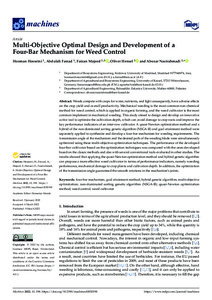| dc.date.accessioned | 2022-05-23T15:10:28Z | |
| dc.date.available | 2022-05-23T15:10:28Z | |
| dc.date.issued | 2022-03-09 | |
| dc.identifier | doi:10.17170/kobra-202205176191 | |
| dc.identifier.uri | http://hdl.handle.net/123456789/13852 | |
| dc.description.sponsorship | Gefördert durch den Publikationsfonds der Universität Kassel | ger |
| dc.language.iso | eng | eng |
| dc.rights | Namensnennung 4.0 International | * |
| dc.rights.uri | http://creativecommons.org/licenses/by/4.0/ | * |
| dc.subject | four-bar mechanism | eng |
| dc.subject | goal attainment method | eng |
| dc.subject | hybrid genetic algorithm | eng |
| dc.subject | multi-objective optimization | eng |
| dc.subject | non-dominated sorting genetic algorithm (NSGA-II) | eng |
| dc.subject | quasi-Newton optimization method | eng |
| dc.subject | weed control | eng |
| dc.subject | weed cultivator | eng |
| dc.subject.ddc | 620 | |
| dc.subject.ddc | 630 | |
| dc.title | Multi-Objective Optimal Design and Development of a Four-Bar Mechanism for Weed Control | eng |
| dc.type | Aufsatz | eng |
| dcterms.abstract | Weeds compete with crops for water, nutrients, and light consequently, have adverse effects on the crop yield and overall productivity. Mechanical weeding is the most common non-chemical method for weed control, which is applied in organic farming, and the weed cultivator is the most common implement in mechanical weeding. This study aimed to design and develop an innovative active tool to optimize the cultivation depth, which can avoid damage to crop roots and improve the key performance indicators of an inter-row cultivator. A quasi-Newton optimization method and a hybrid of the non-dominated sorting genetic algorithm (NSGA-II) and goal attainment method were separately applied to synthesize and develop a four-bar mechanism for weeding requirements. The transmission angle of the mechanism and the desired path of the weeding blade were simultaneously optimized using these multi-objective optimization techniques. The performance of the developed four-bar cultivator based on the optimization techniques was compared with the ones developed based on the classic methods and also with several conventional tools evaluated in other studies. The results showed that applying the quasi-Newton optimization method and hybrid genetic algorithm can propose a more effective weed cultivator in terms of performance indicators, namely weeding performance, mechanical damage to crop plants and cultivation depth. In addition, the optimization of the transmission angle guaranteed the smooth rotations in the mechanism’s joints. | eng |
| dcterms.accessRights | open access | |
| dcterms.creator | Hosseini, Hooman | |
| dcterms.creator | Farzad, Abdulali | |
| dcterms.creator | Majeed, Faizan | |
| dcterms.creator | Hensel, Oliver | |
| dcterms.creator | Nasirahmadi, Abozar | |
| dc.relation.doi | doi:10.3390/machines10030198 | |
| dc.subject.swd | Mechanische Unkrautbekämpfung | ger |
| dc.subject.swd | Optimierung | ger |
| dc.subject.swd | Genetischer Algorithmus | ger |
| dc.subject.swd | Mehrkriterielle Optimierung | ger |
| dc.type.version | publishedVersion | eng |
| dcterms.source.identifier | eissn:2075-1702 | |
| dcterms.source.issue | Issue 3 | |
| dcterms.source.journal | Machines | eng |
| dcterms.source.volume | Volume 10 | |
| kup.iskup | false | eng |
| dcterms.source.articlenumber | 198 | |


